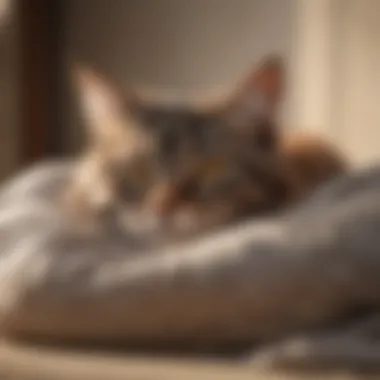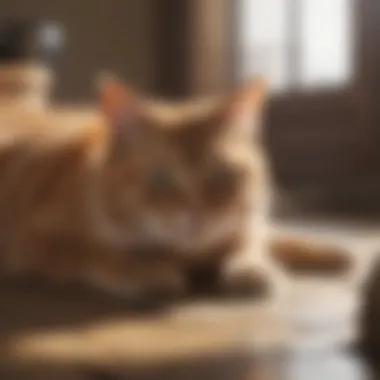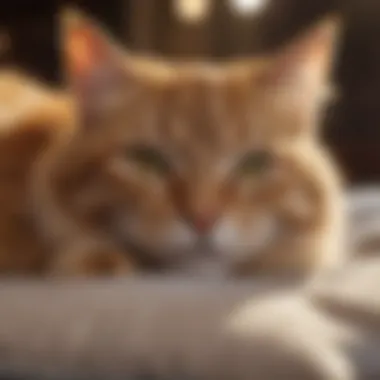Unraveling the Enigmatic Sleep Patterns of House Cats


Animal Species Profile
House cats, scientifically known as Felis catus, have been beloved companions to humans for centuries. With their distinctive physical features and charming personalities, house cats are a common sight in households around the world. Known for their independent nature and graceful movements, these feline creatures have captured the hearts of many.
Physical characteristics and appearance
House cats come in a variety of breeds, each with its own unique characteristics. From the sleek Siamese to the fluffy Persian, these feline friends exhibit a wide range of colors, patterns, and fur lengths. Their sharp retractable claws and keen senses make them agile hunters and adept climbers.
Natural habitat and distribution
Originally descended from wildcats, house cats have adapted to living in human environments. They can be found in homes, urban areas, and even rural settings. While domesticated to be indoor pets, some stray cats may still roam freely in neighborhoods, relying on their instincts to survive.
Behavior and social interactions
House cats exhibit a complex range of behaviors, from hunting and grooming to playful antics and affectionate gestures. While considered solitary animals, they can form close bonds with their human caregivers and other animals in the household. Understanding their behavior is key to providing them with a fulfilling and enriching life.
Introduction
House cats are fascinating creatures known for their unique sleep habits that often leave us in awe. In this article, we embark on a journey to uncover the mysteries behind how much house cats actually sleep. By shedding light on the sleep behaviors of our feline companions, we aim to provide a comprehensive understanding of why they dedicate so much time to rest.
Understanding the Sleep Habits of House Cats
When delving into the sleep patterns of house cats, it becomes apparent that these behaviors are deeply rooted in their evolutionary history. The evolutionary roots of cats' sleep patterns have shaped how they rest and why they exhibit certain behaviors related to sleep. This aspect of feline behavior is crucial in understanding the intrinsic connection between a cat's natural instincts and their need for rest. Exploring the evolutionary origins of cats' sleep habits offers valuable insights into their daily routines and preferences.
The Evolutionary Roots of Cats' Sleep Patterns
One of the key characteristics of the evolutionary roots of cats' sleep patterns is their adaptation to being both predator and prey. This dual role has influenced cats to develop a sleep pattern that allows them to conserve energy for hunting while remaining vigilant to potential dangers. By understanding this unique feature, we can appreciate why cats tend to sleep in short bursts throughout the day.
Variations in Sleep Duration Among Different Cat Breeds
In examining the variations in sleep duration among different cat breeds, we uncover a diverse range of behaviors that contribute to how much each cat sleeps. From the energetic Bengal cat to the laid-back Ragdoll, each breed showcases distinct sleep patterns based on their individual characteristics and needs. Recognizing these variations provides valuable insights into how breed-specific traits influence the duration and quality of a cat's sleep.


Importance of Sleep for Cats
Sleep plays a vital role in the health and well-being of house cats, impacting various aspects of their physical and mental states. Understanding why cats need adequate rest sheds light on the significance of sleep for their overall happiness and quality of life.
Role of Sleep in Feline Health and Well-being
The role of sleep in feline health and well-being is essential for maintaining a cat's optimal physical condition and mental acuity. Adequate rest allows cats to recharge their energy levels, regulate their metabolism, and support cognitive function. By emphasizing the importance of quality sleep, we can help cat owners create a nurturing environment that prioritizes their pet's well-being.
Impact of Sleep Deprivation on Cats
Conversely, the impact of sleep deprivation on cats can lead to a decline in their overall health and behavior. Insufficient rest can result in increased stress, irritability, and a weakened immune system, making cats more susceptible to illness. Recognizing the signs of sleep deprivation is critical in addressing potential issues that may arise from poor sleeping habits.
Factors Influencing Cat Sleep
Exploring the significant topic of Factors Influencing Cat Sleep is essential in unraveling the mysteries of feline slumber. This section will delve into the various elements and considerations that influence how much house cats sleep. By understanding the impact of age, environmental influences, and health conditions on a cat's sleep patterns, readers will gain valuable insights into their feline companions.
Age and Developmental Stage
Sleep Patterns of Kittens vs. Adult Cats
Discussing the differences between the sleep patterns of kittens and adult cats is crucial in understanding how age influences a cat's rest. Kittens tend to sleep considerably more than adult cats, reflecting their rapid growth and development. This subsection will highlight the distinctive sleep behaviors of kittens, such as frequent napping and extended periods of deep sleep. It will also address how adult cats' sleep patterns adjust as they mature, emphasizing any changes in sleep duration and behavior.
Changes in Sleep as Cats Age
Analyzing the shifts in sleep patterns as cats age provides valuable insights into the feline lifecycle. As cats grow older, they may experience alterations in their sleep duration and quality. This section will focus on how senior cats may sleep more lightly or for shorter durations, exploring the reasons behind these changes. By examining how age impacts a cat's sleep, readers will become aware of the evolving needs of their feline companions.
Environmental Influences
Effects of Indoor vs. Outdoor Living
Comparing the effects of indoor and outdoor living on a cat's sleep habits sheds light on the influence of environment. Indoor cats may exhibit different sleep patterns compared to outdoor cats due to varying stimuli and security levels. This part will outline the advantages and disadvantages of each living environment, elucidating how these factors impact a cat's rest.
Creating a Sleep-Conducive Environment


Detailing the significance of a sleep-conducive environment emphasizes the importance of providing cats with a comfortable and secure place to rest. Factors like temperature, lighting, and noise levels play a role in shaping a cat's sleep quality. This subsection will offer practical tips for creating an ideal sleeping space for cats, enhancing their overall well-being.
Health and Medical Conditions
Impact of Illness on Cat's Sleep
Exploring how illnesses affect a cat's sleep patterns is crucial for identifying signs of health issues. Illnesses can disrupt a cat's sleep, leading to changes in their rest patterns and behaviors. This part will highlight common illnesses that impact a cat's sleep and discuss the implications of these conditions on feline health.
Common Sleep Disorders in Cats
Delving into common sleep disorders in cats provides insights into these specific conditions that affect feline rest. From sleep apnea to insomnia, various disorders can disrupt a cat's sleep cycle. This section will outline the symptoms, causes, and potential treatments for these disorders, equipping readers with knowledge to recognize and address sleep-related issues in their cats.
Behavioral Aspects of Cat Sleep
In this section, we delve into the crucial Behavioral Aspects of Cat Sleep, shedding light on the intricate behaviors and patterns exhibited by our feline friends during their rest. Understanding these aspects is vital in comprehending the overall well-being and habits of house cats. By observing and analyzing the behavioral nuances of cat sleep, we can gain valuable insights into their physical and mental health.
Cat Nap Behavior
Frequency and Duration of Cat Naps
Exploring the Frequency and Duration of Cat Naps offers a window into the typical sleeping patterns of cats. Cats are known to take short, frequent naps throughout the day, totaling up to 12-16 hours of sleep in a 24-hour cycle. This unique behavior stems from their natural instincts and biological rhythms, allowing them to conserve energy efficiently. Understanding the distinct sleep cycles of cats provides clues about their evolution and survival strategies.
Reasons Behind Short Naps Throughout the Day
The Reasons Behind Short Naps Throughout the Day are multifaceted and intriguing. Cats' propensity for short naps can be attributed to their predatory nature, enabling them to stay alert and responsive to potential threats in their environment. Furthermore, cats are crepuscular creatures, meaning they are most active during dawn and dusk, leading to a pattern of catnapping to recharge periodically. These short naps also aid in regulating body temperature and maintaining peak cognitive function, supporting their agility and sensory awareness.
Sleeping Positions and Locations
Exploring the Variety of Sleeping Positions Adopted by Cats unveils the range of postures cats assume during rest. Whether curled up in a ball or stretched out lazily, cats exhibit diverse sleeping positions that serve both functional and comfort purposes. Each posture offers insights into their comfort level, sense of security, and thermoregulation strategies. By observing these positions, cat owners can gauge their pets' relaxation levels and emotional state, enhancing their bond and care.
Preferred Sleeping Spots in the Household


Understanding the Preferred Sleeping Spots in the Household provides key insights into cats' environmental preferences and safety considerations. Cats tend to favor cozy nooks, sunny spots, or elevated perches for their slumber, reflecting their natural inclination for warmth and security. By identifying and optimizing these preferred spots, pet owners can create a conducive and comforting sleep environment for their feline companions, ensuring they rest well and feel cherished in their homes.
Managing Cat Sleep
In this insightful article about the sleeping patterns of house cats, delving into how much they actually sleep, the importance of managing cat sleep cannot be overstated. Ensuring that felines get adequate and quality rest is crucial for their overall health and well-being. By focusing on managing cat sleep, cat owners can observe and track their pets' sleep patterns, which can offer valuable insights into their health status. Additionally, by promoting healthy sleep habits in cats, owners can cultivate a harmonious environment that benefits both the cat and the household dynamics.
Establishing a Sleep Routine
Creating a Consistent Bedtime Routine for Cats
Addressing the specific aspect of creating a consistent bedtime routine for cats highlights the significance of routine in feline lives. By establishing a predictable schedule for bedtime, cat owners can help regulate their pets' internal clocks, leading to better sleep quality and overall health. Consistency in bedtime routines also assists in reducing stress and anxiety in cats, promoting a sense of security and stability in their environment. This structured approach fosters a healthier lifestyle, aiding in creating a strong bond between the cat and its owner.
Tips for Promoting Healthy Sleep Patterns
Exploring tips for promoting healthy sleep patterns further underscores the importance of quality rest for cats. Providing a comfortable and quiet sleeping area, maintaining a conducive sleeping environment, and engaging in interactive play sessions during the day can stimulate physical activity, contributing to better sleep at night. Encouraging relaxation techniques such as gentle petting or soothing music before bedtime can help calm a restless cat, facilitating a restful night's sleep. These tips, when incorporated into a cat's routine, can significantly improve their overall sleep quality and well-being.
Handling Disruptions to Cat's Sleep
Dealing with Nocturnal Activity
Navigating the challenge of managing nocturnal activity in cats is essential for maintaining a balanced sleep schedule. Implementing strategies to address nighttime restlessness, such as engaging in play sessions before bedtime to tire out the cat or providing interactive toys for independent play, helps in minimizing disruptive behavior during the night. Creating a peaceful and quiet sleeping environment can also aid in reducing nocturnal disturbances, ensuring that both the cat and the owner get a restful night's sleep.
Addressing Sleep Disturbances
Delving into the aspect of addressing sleep disturbances sheds light on potential underlying issues affecting a cat's sleep. Identifying and alleviating stressors or discomforts that disrupt sleep, such as environmental changes, noise disturbances, or health issues, is crucial in promoting healthy sleep patterns. Consulting with a veterinarian to rule out medical conditions or implementing behavior modification techniques can help address sleep disturbances effectively, ensuring that the cat receives the rest it needs for optimal health and well-being.
Conclusion
In delving deep into the intricate world of feline sleep, this article aims to provide a comprehensive guide on how much house cats sleep. By unraveling the mysteries surrounding their extensive periods of rest, readers can gain valuable insights into the factors influencing these sleep behaviors. Understanding the complex nature of cat sleep can lead to improved care and stronger bonds between humans and their feline companions.
Appreciating the Complexities of Feline Sleep
The Intriguing Nature of Cat Sleep Behaviors
Delving into the intriguing nature of cat sleep behaviors sheds light on the enigmatic world of feline slumber. Cats possess a unique ability to adapt their sleep patterns to their surroundings, displaying a blend of instinctual behavior and environmental influences. This adaptive characteristic allows them to thrive in diverse habitats and maintain their agility. Understanding this key aspect of cat sleep behaviors is crucial in deciphering their overall well-being and fostering a deeper connection with these captivating creatures.
Building a Stronger Bond Through Understanding Cat's Sleeping Patterns
Exploring the intricacies of how cats sleep not only provides valuable insights into their health and behavior but also serves as a pathway to building stronger bonds with these enigmatic animals. By grasping the significance of their sleeping patterns, owners can tailor their care routines to meet their feline companions' needs, leading to enhanced trust and companionship. Understanding and respecting a cat's sleeping habits can elevate the human-feline relationship, fostering mutual respect and appreciation for the unique qualities that make these animals such beloved pets.







